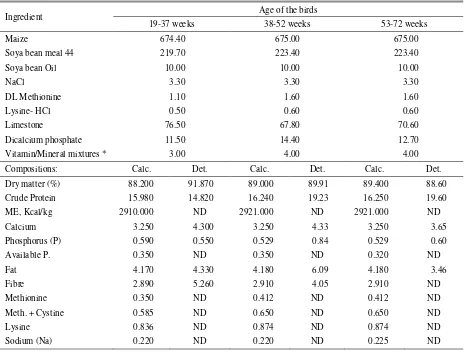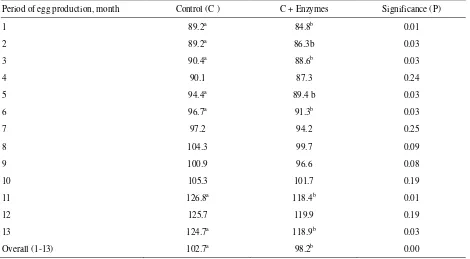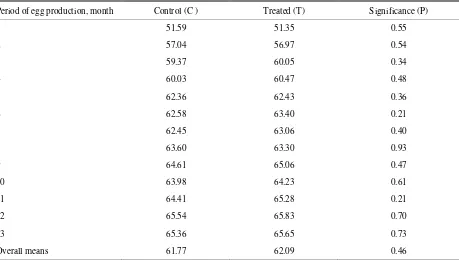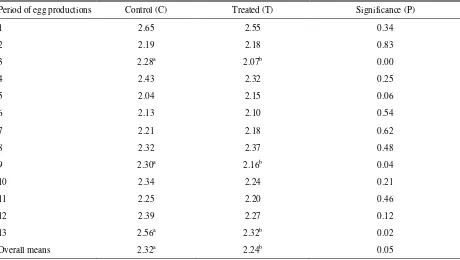The Efficacy of Avizyme 1500 for Improving Performance of Laying Hens
A.P.SINURAT1,P.KETAREN1,A.J.COWIESON2andM.H.L.BENTO3
1Indonesian Research Institute for Animal Production, PO Box 221, Bogor, Indonesia -16720
e-mail: [email protected]
2
Poultry Research Foundation,
University of Sydney, 425 Werombi Road, Camden, NSW 2570, Australia;
3Danisco Animal Nutrition, PO. Box 777, Marlborough, Wiltshire, SN8 1XN, United Kingdom (Diterima 4 Agustus 2012; disetujui 13 September 2012)
ABSTRAK
SINURAT, A.P, P.P. KETAREN, A.J. Cowieson dan M.H.L. BENTO. 2012. Penambahan Avizyme 1500 dalam ransum untuk
meningkatkan performan ayam petelur. JITV 17(3): 221-228.
Suatu percobaan telah dilakukan untuk menguji manfaat penambahan enzim- Avizyme 1500® (Danisco Animal Nutrition, Marlborough, UK) terhadap performan ayam petelur selama periode satu tahun produksi. Ransum kontrol disusun dengan bahan utama terdiri dari jagung dan bungkil kedelai untuk memenuhi kebutuhan gizi ayam petelur strain ISA Brown. Dua perlakuan yang diuji adalah ransum kontrol (C) dan ransum yang diberi enzim (C + 1000 g Avizyme/ton ransum. Setiap jenis ransum diberikan pada 80 ekor ayam petelur (20 ulangan dan 4 ekor/ulangan) mulai umur 20 hingga 72 minggu. Selama percobaan tersebut dilakukan pengamatan terhadap performan ayam petelur (konsumsi pakan, produksi telur, bobot telur, total berat produksi telur atau egg mass, konfersi pakan atau FCR, mortalitas, perubahan bobot badan dan kualitas telur). Perbedaan
perlakuan dianalisis dengan menggunakan t-test. Hasil penelitian menunjukkan bahwa penambahan Avizyme 1500 kedalam pakan dapat menurunkan konsumsi pakan 4% (P < 0,01), mengurangi mortalitas dari 15% menjadi 3,75% (P < 0.01) serta memperbaiki efisiensi penggunaan pakan (FCR) sebanyak 3% (P < 0,05). Mortalitas yang tinggi pada ayam kontrol (15%) terjadi karena adanya infeksi E.coli, sesuai uji post-mortem yang dilakukan. Akan tetapi, produksi telur (HD and HH), bobot
telur dan massa telur tidak nyata dipengaruhi oleh penambahan Avizyme didalam pakan. Kualitas telur (HU, indeks kuning telur, bobot kuning telur dan tebal kerabang tidak nyata dipengaruhi oleh penambahan Avizyme dalam ransum. Oleh karena itu disimpulkan bahwa penambahan 1000 g Avizyme /ton ransum dapat memperbaiki efisiensi penggunaan pakan (FCR) sebagai akibat penurunan konsumsi pakan, tanpa merubah produktifitasnya.
Kata Kunci: Produksi Telur, Enzim, Efisiensi Penggunaan Pakan (FCR), Kualitas Telur
ABSTRACT
SINURAT, A.P, P.P. KETAREN, A.J. COWIESON and M.H.L. BENTO. 2012. The efficacy of avizyme 1500 for improving performance of laying hens. JITV 17(3): 221-228.
A trial was conducted in order to study the effect of the supplementation of Avizyme 1500® (Danisco Animal Nutrition, Marlborough, UK) on the performance of laying hens for one year. A control diet based on corn – soybean meal was formulated to meet nutrient requirement of ISA Brown laying hens. Two treatments, the control diet (C) and C + 1000 g Avizyme/tonne diet were tested. Each diet was fed to 80 birds (20 replicates of 4 birds) from 20 to 72 weeks of age, and performances of birds (feed intake, egg production, egg size, egg mass, feed conversion ratio, and egg quality) were measured. All data were subject to analyses of variance following the t-test. Results showed that the addition of Avizyme 1500 to the feed reduced feed intake by 4% (P < 0.01), mortality by 75 % or from 15% to 3.75% (P < 0.01) and improved the feed conversion ratio by 3 % (P < 0.05). The high mortality of the control treatment (15%) is explained by an E.coli infection that was observed following the post-mortem examination of dead birds. The egg production (HD and HH), egg size and egg mass however were not significantly affected by the Avizyme supplementation. Egg quality (HU, yolk colour score, yolk weight and shell thickness) was not significantly affected by Avizyme supplementation. It can be concluded that the supplementation of 1000 g Avizyme /tonne of diet improved feed efficiency and this was mediated via a reduction in feed intake.
Key Words: Egg Production, Enzyme, Feed Convertion Ratio, Egg Quality
INTRODUCTION
Enzymes are naturally produced in all living organisms which act as catalyst to accelerate chemical reactions in the biological system. Nowadays, supplementation of exogenous enzymes have been
wheat, wheat pollard, barley, deoiled rice bran, soybean
reported to reduce the intestinal digesta viscosity and improved the nutrient digestibilily. Improvement in the nutrient digestibility of the feed due to enzymes supplementation were followed by the improvement in broilers performance (GARCIA et al., 2008; JIA and normally regarded as highly digestible for poultry, with relatively low NSPs content (MENG and SLOMINSKI, 2005). Therefore, the benefit of inclusion of exogenous enzyme in such diet are often questioned. CHESSON
(2001) reviewed some literatures and concluded that inclusion of commercial enzyme preparations in maize-soyabean diets have failed to produce the benefits observed with other cereal-based diets. However, there are evidence that the nutrient values of corn (COWIESON, 2005) and soybean meal (DE COCA
-SINOVA et al., 2008) are variable. Some proofs that the
supplementation of exogenous enzyme in corn-soybean diet improved the body weight 0.5 to 10.9% and the FCR 0.78 to10.5% over control (COWIESON, 2005). Therefore, a trial was designed to study the effect of supplementation of a multi enzyme (consist of xylanase, amylase and protease) in improving the performance of laying hens.
MATERIALS AND METHODS
A trial was conducted to study the efficacy of an enzyme Avizyme 1500® (Danisco Animal Nutrition, Marlborough, UK) in laying hens at the poultry unit of the Indonesian Research Institute for Animal Production (Balai Penelitian Ternak), Bogor-Indonesia. One hundred and sixty (160) pullets - 18 weeks of age, strain Isa Brown were weighed individually and distributed randomly into individual cages. Each four cages were equiped with one feeder and considered as a replicate. The birds were reared according to normal laying hens management practices and feed and water were always available during the trial.
Two (2) treatments were tested in this trial. The treatments consisted of: A diet without enzyme supplementation (marked as Control or C) and C + Enzyme (T). The enzyme tested was the Avizyme 1500® wich contains 600 U/g endo- 1,4 beta xylanase EC 3.2.1.8; 1600 U/g alpha amylase EC 3.2.1.1. and 4000 U/g protease EC 3.4.21.62. The control diet was formulated based on corn-soyabean meal, to meet the nutrient requirement of the laying hens which were adjusted according to the age of the birds (Table 1). No antibiotic nor coccidiostat was given in the feed during the trial. The dietary treatments were allocated randomly with 20 replicates each. The enzyme tested was mixed at 1000 g/tonne (T) in the diet. The diet was prepared in mash form and fed to the birds from 19 weeks to 72 weeks old or 52 weeks of egg production.
Birds were weighed individually at the beginning of the trial (at 19 weeks old age) and at the end of the trial times, i.e., at 31 and 67 weeks of age. The egg quality traits measured were: haugh unit (HU), egg yolk colour and shell thickness. Feed conversion ratio (FCR) was calculated by dividing the feed intake (gram) with the egg mass (gram) produced at the same period of time. The mortality of the birds were also recorded. The significance of differences between experimental and control groups was tested by a student’s t-test (2
treatments and 20 replicates) following the procedures described by STEEL and TORRIE (1980).
RESULTS AND DISCUSSION
The mortality and the average body weight gain of birds during the one (1) year trial is shown in Table 2. The results showed that inclusion of the Avizyme 1500@ in the diet did not significantly (P > 0.05) affect the average body weight gain of birds during one year trial. JALAL et al. (2007) also reported that
supplementation of similar enzyme in the diet did not change the body weight of 3 (three) strains of laying hens fed for 28 weeks period. However, the enzyme supplementation significantly (P < 0.01) reduced the mortality of the birds from 15.00, to 3.75%. Post mortem analyses carried out on dead birds showed that the mortality was due to infections caused by E. coli
(Colibasilosis) and Haemophylus paragallinarum
(Coryza). Some dead birds were also found to have broken eggs in the abdomen cavity (egg yolk peritonitis), suspected as a result of infection by E. coli
reduce the population of pathogenic bacteria in the digestive tracts of the birds (VAHJEN et al., 1998;
ENGBERG et al., 2004). This may explain the lower
mortality rates in birds fed enzyme- supplemented diet. Feed intake of the birds during the one-year egg production is presented in Table 3. In all periods of observation, birds fed enzyme- supplemented diet have a lower feed intake than the control birds, although it was only statistically significant (P < 0.05) at 1st, 2nd, 3rd, 5th, 6th, 11th and 13th periods. The overall mean
(from 21-72 weeks of age) of feed intake of birds fed enzyme- supplemented diet was also significantly (P < 0.01) lower than those fed the control diet, i.e., 98.2 vs. 102.7 g/bird/d, respectively. SCHEIDELERet al.
(2005) and JALAL et al. (2007) reported that similar
enzyme (Avizyme@) supplementation in the corn- soya- based diet did not affect the feed intake significantly. This may be related to the lower dose of the enzyme applied in their study, i.e. 750 g/tonne feed.
Table 1. Composition of the control diet during the trial (g/kg)
Ingredient Age of the birds
19-37 weeks 38-52 weeks 53-72 weeks
Maize 674.40 675.00 675.00
Soya bean meal 44 219.70 223.40 223.40
Soya bean Oil 10.00 10.00 10.00
NaCl 3.30 3.30 3.30
DL Methionine 1.10 1.60 1.60
Lysine- HCl 0.50 0.60 0.60
Limestone 76.50 67.80 70.60
Dicalcium phosphate 11.50 14.40 12.70
Vitamin/Mineral mixtures * 3.00 4.00 4.00
Compositions: Calc. Det. Calc. Det. Calc. Det.
Dry matter (%) 88.200 91.870 89.000 89.91 89.400 88.60
Crude Protein 15.980 14.820 16.240 19.23 16.250 19.60
ME, Kcal/kg 2910.000 ND 2921.000 ND 2921.000 ND
Calcium 3.250 4.300 3.250 4.33 3.250 3.65
Phosphorus (P) 0.590 0.550 0.529 0.84 0.529 0.60
Available P. 0.350 ND 0.350 ND 0.320 ND
Fat 4.170 4.330 4.180 6.09 4.180 3.46
Fibre 2.890 5.260 2.910 4.05 2.910 ND
Methionine 0.350 ND 0.412 ND 0.412 ND
Meth. + Cystine 0.585 ND 0.650 ND 0.650 ND
Lysine 0.836 ND 0.874 ND 0.874 ND
Sodium (Na) 0.220 ND 0.220 ND 0.225 ND
ND = Not determined; Calc. = calculated; Det.= determined.
*Each 1 kg contain: Vitamin A, 1,000,000 IU; Vitamin D3, 800,000 IU; Vitamin E, 4500 mg; Vitamin K3, 450 mg; VitaminB1, 450 mg; Vitamin B2, 1350 mg; Vitamin B6, 480 mg; Vitamin B12, 6 mg; Ca –d-pantothenate, 2400 mg; Folic acid, 270 mg; Nicotinic acid, 7200 mg; Ferros, 8300 mg; Copper, 700 mg; Manganese, 18500 mg; Zinc, 14,000 mg; Cobalt, 50 mg; Iodine, 70 mg; Selenium, 35 mg.
Table 2. Mortalities and body weight changes of chickens during one- year feeding trial
Observations Treatments (Dose of enzyme in feed) Significance (P)
0 g/ton (Control) 1000 g/ton (Treated)
Mortalities (%) 15.00a 3.75b 0.01
Table 3. Feed intake of laying hens during one year egg production (g/bird)
Period of egg production, month Control (C ) C + Enzymes Significance (P)
1 89.2a 84.8b 0.01
2 89.2a 86.3b 0.03
3 90.4a 88.6b 0.03
4 90.1 87.3 0.24
5 94.4a 89.4 b 0.03
6 96.7a 91.3b 0.03
7 97.2 94.2 0.25
8 104.3 99.7 0.09
9 100.9 96.6 0.08
10 105.3 101.7 0.19
11 126.8a 118.4b 0.01
12 125.7 119.9 0.19
13 124.7a 118.9b 0.03
Overall (1-13) 102.7a 98.2b 0.00
a bMeans within a row with different superscript are significantly different (P < 0.05)
C = Control (no enzyme); T = Control + 1000 g enzyme /tonne feed.
Egg production, egg weight and egg quality
Data on hen day egg production (HD) and hen house egg production (HH) of laying hens during one-year feeding trial is presented in Table 4. Results showed that the HD egg production was only significant (P < 0.05) during the 3rd and 4th period. However, results during the whole period, the dietary enzyme supplementation did not affect the hen-day egg production significantly (P > 0.05).
The HH egg production was only statistically significant (P < 0.05) at 3rd, 12th and 13th period of trial. In these periods, birds fed the control diet produced significantly (P < 0.05) less HH egg production than those fed with enzyme supplemented diet. The overall HH egg production was not significantly (P > 0.05) affected by the dietary enzyme supplementation. The overall mean HH egg production during one-year trial was 75.2 and 78.5% for birds fed the control diet (C) and enzyme supplemented (T) diet, respectively.
Data on the effect of enzyme supplementation in the diet on the egg size during one-year feeding trial is presented in Table 5. The egg size was not significantly
(P > 0.05) affected by dietary enzyme supplementation at all periods, although the egg size of birds fed enzyme supplemented diet tend to be heavier than the control. The average egg size during the whole period of birds fed the control diet was 61.77 g/egg and birds fed enzyme supplemented diet was 62.09 g/egg.
Table 4. Hen-day (% HD) and Hen –house (% HH) egg production of laying hens during the trial
a bMeans within a row with different superscript are significantly different (P < .05)
C = Control (no enzyme); T = Control + 1000 g enzyme /tonne feed.
Table 5. Average egg size (g/egg) of birds fed diet supplemented with enzyme during the trial (13 periods of 4 weeks)
Period of egg production, month Control (C ) Treated (T) Significance (P)
1 51.59 51.35 0.55
2 57.04 56.97 0.54
3 59.37 60.05 0.34
4 60.03 60.47 0.48
5 62.36 62.43 0.36
6 62.58 63.40 0.21
7 62.45 63.06 0.40
8 63.60 63.30 0.93
9 64.61 65.06 0.47
10 63.98 64.23 0.61
11 64.41 65.28 0.21
12 65.54 65.83 0.70
13 65.36 65.65 0.73
Overall means 61.77 62.09 0.46
C = Control (no enzyme); T = Control + 1000 g enzyme /tonne feed.
Period of egg production (month) Hen-day egg production (%) Hen house egg production (%) Control (C ) Treated (T) Significance (P) Control (C ) Treated (T) Significance (P)
1 70.09 70.58 0.90 70.0 70.6 0.89
2 80.95 79.29 0.38 80.6 78.8 0.50
3 79.34a 85.31b 0.01 77.3a 85.3b 0.00
4 73.80 74.11 0.99 71.3 73.1 0.63
5 86.73a 79.97b 0.01 81.7 77.6 0.25
6 84.88 81.50 0.21 78.7 79.3 0.84
7 84.38 81.55 0.28 77.8 79.4 0.65
8 83.27 80.02 0.12 76.5 76.5 0.97
9 84.29 84.73 0.86 76.2 81.4 0.16
10 84.84 86.43 0.60 76.7 83.2 0.12
11 85.57 83.41 0.55 75.8 80.4 0.21
12 81.47 81.07 0.53 69.9 a 78.1b 0.03
13 76.40 79.23 0.15 65.4a 76.3b 0.01
Feed conversion ratio
Data on feed conversion ratio (FCR) of laying hens during one-year egg production period is presented in Table 7. Statistical analyses showed that the only significant effect of enzyme dietary supplementation on the feed conversion ratio of laying hens was found at the 3rd, 9th, and 13th period (P < 0.05). In this period, the FCR of birds fed enzyme supplemented diet (1000 g enzyme/tonne feed) was significantly better than those fed with the control diet. The overall means of feed conversion ratio (FCR) for one-year trial were also significantly (P = 0.05) affected by the enzyme supplementation in the diet. The FCR of the birds fed
with control diet was 2.32 and supplementation of enzyme (1000 g enzyme/tonne feed) improved the FCR of the birds to 2.24.
Feed intake of birds in this study was quite low (i.e., 102.7 g/bird/day) as compared to normal intake of semi-heavy laying hens (Isa Brown strain). The standard feed intake of the Isa Brown birds during production period according to breeder standard is 115 g/bird/day (HUTAGALUNG, 2000). However, the low
feed intake in this study may be due to a high ME of the diet (2900 kcal/kg). Results of this study showed that there was a significant reduction in feed intake by laying hens given 1000 g enzyme/tonne. The reduction was about 4% or approximately 4 g/bird/day. As it is
Table 6. Egg quality of birds fed enzyme- supplemented diet (at 31 and 67 weeks of age)
Parameters
at 31 weeks of age at 67 weeks of age
Control (C ) Treated (T) Significance (P) Control (C ) Treated (T) Significance (P)
Yolk colour score 6.5 6.2 0.07 6.0 5.8 0.48
Yolk weight, g/egg 14.1 17.0 0.25 16.0 17.0 0.08
Haugh Unit (HU) 88.4 88.9 0.63 89.6 90.4 0.61
Shell weight, g/egg 6.2 6.2 0.71 6.1b 7.0a
0.00
Shell thickness, mm 0.41 0.41 0.69 0.46 b 0.50 a
0.01
C = Control (no enzyme); T = Control + 1000 g enzyme /tonne feed.
a bMeans within a row with different superscript are significantly different (P < .05)
Table 7. Feed conversion ratio of laying hens during the trial (13 periods of 4 weeks)
Period of egg productions Control (C) Treated (T) Significance (P)
1 2.65 2.55 0.34
2 2.19 2.18 0.83
3 2.28a 2.07b 0.00
4 2.43 2.32 0.25
5 2.04 2.15 0.06
6 2.13 2.10 0.54
7 2.21 2.18 0.62
8 2.32 2.37 0.48
9 2.30a 2.16b 0.04
10 2.34 2.24 0.21
11 2.25 2.20 0.46
12 2.39 2.27 0.12
13 2.56a 2.32b 0.02
Overall means 2.32a 2.24b 0.05
a bMeans within a row with different superscript are significantly different (P < .05)
well known that feed intake of birds are controlled by the energy level in the diet. Since many study have shown that supplementation of enzyme increased the metabolisable energy of the diet (BEDFORD, 1995;
SELLE et al., 2003; MCDEVITT et al., 2004; CHENG et al., 2005), explains the reduction of feed intake in this
study as a reflection of an increase in energy of the diet due to the enzyme supplementation.
A significant reduction in the mortality of birds during the one-year feeding trial was found in this trial. Veterinary examinations indicated that most of the dead birds caused by disturbances in the gastrointestinal tract. Supplementing the enzyme in the diet may have provided a better and healthier gastrointestinal of the birds, hence reduce the mortality. Previous reports (BEDFORD, 2000; SINLAE and CHOCT, 2000) showed
that the population of pathogenic bacteria in the gastrointestinal of birds reduced when enzymes were included in the diet. The level of mortality of the control birds in this study was quite high as compared to standard performance of Isa Brown strain (6.7%) or normally found at the farmer level (8.2%) as reported by HUTAGALUNG (2000). This may be due to the fact
that antibiotic and/or coccidiostat was not supplemented in the diet as normally practiced in commercial feed in Indonesia.
This study showed that the egg production (hen-day nor hen-house, egg mass production) and the egg size were not significantly affected by the enzyme supplementation in the diet. However, the HH and egg mass production of birds fed the Avizyme 1500@ (1000 g/tonne feed) tend to be higher than the control due to a less mortality rate. The high nutrient density of the control diet (ME 2900 kcal/kg and CP 16%) used in this study may have provide sufficient nutrients to support the optimum egg production, and therefore any improvement in the nutrient availability due to the enzyme supplementation was not significantly reflected in the addition of egg production.
Results of this study also showed that the feed conversion ratio was significantly improved by the Avizyme 1500@ supplementation at the 3rd, 12th, 13th period and also during one year period. The percentage of improvement as affected by inclusion of the Avizyme 1500@ varied from 3.4% (the FCR for one year period) to 10.7% (the FCR at 13th period) as compared to the control. This results may reflect that there was a high variability between birds used in this experiment. This variability may be reduced when larger number of birds are to be used in the trial or when the homogeneity of the feed mixing is improved.
This study showed that the egg quality of laying hens was not affected by dietary enzyme supplementation when the egg quality was measured at 31 weeks old or 12 weeks after treatment. However, the response was different when measured in a longer
period (at 67 weeks of age), in which egg shell weight and egg shell thickness were significantly improved when birds fed with enzyme-supplemented diet.
CONCLUSION
This study conclude that the supplementation of the Avizyme 1500@ in the corn-soya diet improved the performances of laying hens as indicated by a reduction of birds mortality and feed intake and improvement in feed convertion ratio.
REFERENCES
BEDFORD, M.R. 1995. Mechanisms of action and potential environmental benefits from the use of feed enzymes.
Anim. Feed Sci. Technol. 53: 145-155.
BEDFORD, M.R. 2000. Exogenous enzymes in monogastric nutrition – their current value and future benefits. Anim. Feed Sci. Technol. 86: 1-13.
BEDFORD, M.R. and H.L.CLASSEN. 1993. An in vitro assay
for prediction of broiler intestinal viscosity and growth when fed rye-based dieys in the presence of Exogenous enzymes. Poult. Sci. 72: 137-143.
CHENG,J.I.,Y.B.WU.,C.MIAO,R.M.KING and M. PURSER. 2005. The effect of a novel enzyme complex on the performance and nutrient digestibility in laying hens fed a corn-soy diet. Proc. Aust. Poult. Sci. Symp. Uni. of Sydney, Sydney. NSW. Vol. 17: 229-233.
CHESSON, A. 2001. Non-starch polysaccharide degrading enzymes in poultry diets: Influence of ingredients on the selectionn of activities. World’s Poult. Sci. J. 57: 251-263.
CHOCT, M. 1997. Feed non-starch polysaccharides: Chemical structures and nutritional significance. Feed Milling Int.
7: 13-26.
COWIESON, A.J. 2005. Factors that affect the nutritional value of maize for broilers. Anim. Feed Sci. Technol. 119: 293-305.
DE COCA-SINOVA, A., D.G. VALENCIA, E. JIMÉNEZ-MORENO, R. LÁZARO and G.G. MATEOS. 2008. Apparent ileal digestibility of energy, nitrogen, and amino acids of soybean meals of different origin in broiler. Poult. Sci.
87: 2613-2623.
ENGBERG, R.M., M.S. HEDEMANN, S. STEENFELDT and B.B. JENSEN. 2004. Influence of whole wheat and xylanase on broiler performance and microbial composition and activity in the digestive tract. Poult. Sci. 83: 925-938.
GUTIERREZDEL ALAMO,A.G.,M.W.A.,VERSTEGEN,L.A. DEN HARTOG, P. PEREZ DE AYALA and M.J. VILLAMIDE. 2008. Effect of wheat cultivar and enzyme addition to broiler chicken metabolizable energy content. Poult. Sci. 87: 759-767.
GARCIA, M., R. LAZARO, M.A.LATORRE, M.I. GRACIA and G.G. MATEOS. 2008. Influence of enzyme supplementation and heat processing of barley on digestive traits and productive performance of broilers.
Pout. Sci. 87: 940-948.
HUTAGALUNG, R.I. 2000. The monetary crisis and its impact on the development of the poultry in Indonesia. Proc. Aust. Poult. Sci. Symp. Uni. of Sydney, Sydney. NSW.
Vol. 12: 74-81.
JALAL, M.A., S.E. SCHEIDELER and E.M. PIERSON. 2007. Strain response of laying hens to varying dietary energy levels with and without avizyme supplementation. J. Appl. Poult. Res. 16: 289-295.
JIA, W.and B.A.SOLOMINSKI. 2010. Means to improve the nutritive value of flaxseed for broiler chickens: The effect of particle size, enzyme addition, and feed pelleting. Poulkt. Sci. 89: 261-269.
LAZARO,R.,M.GARCÍA,P.MEDEL and G.G.MATEOS. 2003. Influence of enzymes on performance and digestive parameters of broilers fed rye-based diets. Poult Sci.
82: 132-40.
MALATHI,V. and G. DEVEGOWDA, 2001. In vitro evaluation of nonstarch polysaccharide digestibility of feed ingredients by enzymes. Poult. Sci. 80: 302-305.
MCDEVITT, R.M.,T. ACAMOVIC and N.H.C. SPARKS. 2004. The effect of the supplementation of broiler breeder diets with enzymes on nutrient utilisation by their progeny. XII World’s Poultry Congress. Book of Abstracts. pp. 445. Istanbul, Turkey.
MENG,X. and B.A.SLOMINSKI. 2005. Nutritive value of corn, soybean meal, canola meal, and peas for broiler chickens as affected by a multicarbohydrase preparation of cell wall degrading enzymes. Poult. Sci. 84:
1242-1251.
SELLE,P.H.,V.RAVINDRAN,G.RAVINDRAN,P.H.PITTOLO and W.L.BRYDEN. 2003. Influence of phytase and xylanase supplementation on growth performance and nutrient utilization of broilers offered wheat-based diets. Asian-Aust. J. Anim. Sci. 16: 394-402.
SINLAE,M.and M.CHOCT. 2000. Xylanase supplementation affects the caecal microflora of broilers. Proc. Aust. Poult. Sci. Sym. Vol. 12: 209.
STEEL, R.G.D. and J.H. TORRIE. 1980.Principles and Procedures of Statistics. 2nd. Mc. Graw Hill, New York.
SCHEIDELER, S.E., M.M. BECK, A. ABUDABOS and C.L. WYATT. 2005. Multiple-enzyme (Avizyme) supplementation of corn-soy-based layer diets. J. Appl. Poult. Res. 14: 77-86.



